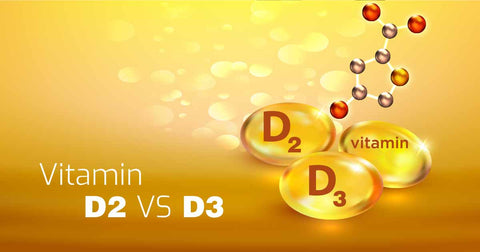Vitamin D is not just one fat-soluble vitamin but a group of them. They are long known to help the body absorb and retain minerals essential for building strong bones like calcium, phosphorus, and magnesium.
What we know as Vitamin D is essentially a collective term for its two types: vitamin D2 and vitamin D3. Recent research suggests that these forms may have different effects on the body. Then, what is the difference between vitamin D2 and D3? And is one more beneficial than the others?
This article here will talk about the difference between vitamin D2 and D3, including how we can get them, their effects on the body, and which one you should take!
But before we jump to the difference between vitamin D2 and D3, let's first begin by understanding Vitamin D itself.
Vitamin D: What is it?
Vitamin D, also known as Calciferol, is a vitamin that can dissolve in fats and oils. Therefore, they are absorbed along with fats in the diet, and stored in fatty tissues of the body and the liver.
Generally, a vitamin is a substance the body cannot produce on its own. But Vitamin D, often called "the sunshine vitamin," is synthesized in the body when you expose your skin to sunlight. So, technically Calciferol is not a vitamin but a prohormone.
Vitamin D is essential for a range of bodily functions. Not only does it promote the absorption of bone-building minerals from the gut, but it also helps maintain adequate levels of them in the blood.
It also plays a vital role in the nervous system and muscle movement, thereby helping prevent muscle cramps and spasms. Vitamin D is also known to enhance the function of immune cells, with some recent research indicating that it may help in COVID-19 infections.
While humans can produce Vitamin D, if you live in winter climates or spend most time indoors or at work unable to bask in the sun, your body will have trouble producing enough amounts to meet your needs. That's when you have to boost your intake through food or supplements.
The vitamin D family includes five forms, but the two most important ones in humans are vitamin D2 and D3. Although they are often used interchangeably, they are not quite the same.
Both the vitamins are inactive until a two-step process in the body. The first is a change in their chemical structure. The liver changes the inactive vitamins to form calcidiol, which is how it is stored in the body. Calcidiol is further altered in the kidney, forming the final active form: calcitriol.
You may ask what the difference between vitamin D2 and D3 is? Let's explore these differences together.
What is the difference between vitamin D2 and D3?
Vitamin D2 (also called ergocalciferol) and Vitamin D3 (or cholecalciferol). These are the two most important forms of Vitamin D.
Now, let's look at the difference between vitamin D2 and D3 in detail:
Sources of Vitamin D
 One of the most significant differences between vitamin D2 and D3 is that Vitamin D2 and D3 are derived from different sources.
One of the most significant differences between vitamin D2 and D3 is that Vitamin D2 and D3 are derived from different sources.
Ergocalciferol is derived from plants, whereas cholecalciferol comes from animals.
Dietary sources of vitamin D2 are foods fortified with the vitamin, wild mushrooms, and mushrooms grown under UV light.
Because vitamin D2 is cheaper to produce, it is the most common form in fortified foods. Common D2-fortified foods include orange juice, breakfast cereal, milk and plant-based milk alternatives (such as oat, almond, and soy), margarine, etc.
Food that contains a high amount of vitamin D3 is fish oil (cod liver oil) and fatty fishes such as tuna, salmon, sardines, and mackerel. It is also present in trout, red meat, egg yolk, butter, cheese, and dietary supplements.
Structure of Vitamin D
Another difference between vitamin D2 and D3 is in their molecular structures. While we won't get to the nitty-gritty science, the difference lies in their weight and side chains.
The side chain of vitamin D3 has a broken ring, while D2 has a double bond. It is unclear if this difference has any impact on human health.
Discovery of Vitamin D
Since we are talking about the difference between vitamin D2 and D3, let's also take a quick look at how these were discovered.
Vitamin D2 was the first vitamin D to be isolated and identified in 1932. Years later, in 1937, vitamin D3 was then identified.
Synthesis of Vitamin D

 The next difference between vitamin D2 and D3 is how they are synthesized.
The next difference between vitamin D2 and D3 is how they are synthesized.
Vitamin D3 is formed in the skin when exposed to sunlight. The sun's ultraviolet B (UVB) radiation triggers the formation of vitamin D3 from the compound 7-dehydrocholesterol.
A similar process takes place in mushrooms and plants to synthesize vitamin D2. UVB light leads to the formation of vitamin D2 from ergosterol, a compound found in plant oils.
Potency of Vitamin D
Another difference between vitamin D2 and D3 lies in their potency. Let's take a look at what we know so far.
Initially, it was thought that vitamin D2 and D3 were equivalent. However, some food scientists and nutritionists theorize that D2 is less effective than D3.
Some believe D2 has a shorter shelf life and does not get absorbed into the bloodstream well. It is also thought that the key difference between vitamin D2 and D3 is that vitamin D2 yields higher levels of calcidiol when compared to vitamin D2.
For instance, a 2008 study on 32 older women with vitamin D deficiency found that a single dose of Vitamin D3 was almost twice as effective as vitamin D2 at raising calcidiol levels.
There are even concerns regarding the difference in the quality of supplements. Scientists believe that the difference between Vitamin D2 and Vitamin D3 is that Vitamin D2 supplements might be lower quality than D3 supplements.
Some studies suggest vitamin D2 is more sensitive to humid environments and temperature fluctuations. It is more likely that vitamin D2, for this very reason, may degrade over time.
But having said all of this, its relevance to human health is still unknown because no studies have compared the stability of the two forms of vitamins dissolved in fats.
Uses
Although there are some conflicting results, the next difference between vitamin D2 and D3 is their uses.
Some studies may prefer ergocalciferol for treating chronic kidney disease (CKD) patients. However, clinical practices support supplementation with either D2 or D3 in CKD.
Ergocalciferol is indicated to treat calcium disorders and decrease the functioning of parathyroid glands (or hypoparathyroidism). It may also be used to treat the softening of bones caused by Vitamin D deficiency (rickets) and hypophosphatemia, a condition with low levels of phosphate in the blood.
Ergosterol, the precursor oil of vitamin D2, can efficiently absorb UV radiation that can damage the cellular structures in the body. Natural ergosterol can function as a sun protection system that may be potentially utilized to make sunscreens.
Cholecalciferol is also used to treat people with vitamin D deficiency or related disorders like osteomalacia and rickets.
So which should I take?
 Now that the difference between vitamin D2 and D3 has been laid out, you might be wondering which is the better one and which I should take?
Now that the difference between vitamin D2 and D3 has been laid out, you might be wondering which is the better one and which I should take?
If you are a committed vegetarian, then vitamin D2 is the only dietary or supplemental form of vitamin D that complies with your diet. This is beyond the D3 you make yourself when your skin is exposed to the sun.
If you are not vegetarian or vegan, many studies support taking vitamin D3. Some research says the body better converts it, and some even say it is almost twice as effective. More human studies are required to examine the relevance of the difference between vitamin D2 and D3.
Regardless, consistency is the key, and supplements containing either of the forms will be beneficial when taken routinely as recommended by your healthcare provider.
The final points
Vitamin D is essential for maintaining the health of bones, teeth, nerves, muscles, and the immune system. There are two main forms of the vitamin: D2 and D3. While both perform the same role in the body, scientists are not sure if either one is better than the other.
So, here's a quick recap of everything we have learned regarding the difference between vitamin D2 and D3 so far.
Vitamin D2 is plant-derived, whereas D3 is sourced from animals. When exposed to sunlight, eventually, both are converted into active forms in the body. They are different in their molecular weight and chemical structure.
Some studies have found that vitamin D3 is more effective in raising blood levels of Vitamin D than D2. It is also believed that the difference between Vitamin D2 and D3 is that D2 has a shorter shelf life and does not get absorbed into the bloodstream well. But there are debates about whether this can be relevant to human health. Make sure you are taking your supplements regularly, whether D2 or D3.
Watch AFIL test kits testimonial videos click here
Resources
- Aranow, Cynthia. "Vitamin D and the immune system." Journal of investigative medicine: the official publication of the American Federation for Clinical Research vol. 59,6 (2011): 881-6. doi:10.2310/JIM.0b013e31821b8755
- Sirajudeen, Shaima et al. "A Narrative Role of Vitamin D and Its Receptor: With Current Evidence on the Gastric Tissues." International Journal of molecular sciences vol. 20,15 3832. 5 Aug. 2019, doi:10.3390/ijms20153832
- Alshahrani, Fahad, and Naji Aljohani. "Vitamin D: deficiency, sufficiency, and toxicity." Nutrients vol. 5,9 3605-16. 13 Sep. 2013, doi:10.3390/nu5093605
- Jäpelt, Rie B, and Jette Jakobsen. "Vitamin D in plants: a review of occurrence, analysis, and biosynthesis." Frontiers in plant science vol. 4 136. 13 May. 2013, doi:10.3389/fpls.2013.00136
- Deluca, Hector F. "History of the discovery of vitamin D and its active metabolites." BoneKEy reports vol. 3 479. 8 Jan. 2014, doi:10.1038/bonekey.2013.213
- Romagnoli, Elisabetta et al. "Short and long-term variations in serum calciotropic hormones after a single very large dose of ergocalciferol (vitamin D2) or cholecalciferol (vitamin D3) in the elderly." The Journal of clinical endocrinology and metabolism vol. 93,8 (2008): 3015-20. doi:10.1210/jc.2008-0350
- Tripkovic, Laura et al. "Comparison of vitamin D2 and vitamin D3 supplementation in raising serum 25-hydroxyvitamin D status: a systematic review and meta-analysis." The American Journal of clinical nutrition vol. 95,6 (2012): 1357-64. doi:10.3945/ajcn.111.031070
- Glendenning, Paul et al. "Calculated free and bioavailable vitamin D metabolite concentrations in vitamin D-deficient hip fracture patients after supplementation with cholecalciferol and ergocalciferol." Bone vol. 56,2 (2013): 271-5. doi:10.1016/j.bone.2013.06.012
- Houghton, Lisa A, and Reinhold Vieth. "The case against ergocalciferol (vitamin D2) as a vitamin supplement." The American Journal of clinical nutrition vol. 84,4 (2006): 694-7. doi:10.1093/ajcn/84.4.694
- Wacker, Matthias, and Michael F Holick. "Sunlight and Vitamin D: A global perspective for health." Dermato-endocrinology vol. 5,1 (2013): 51-108. doi:10.4161/derm.24494


.png?v=1737390083)
.png?v=1737187409)


